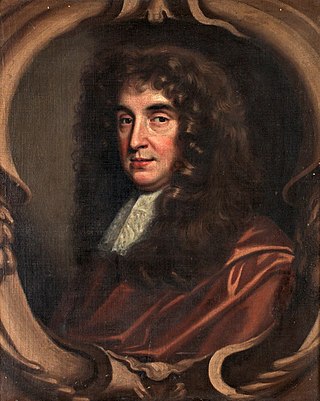
Samuel Pepys was an English diarist and naval administrator. He served as administrator of the Royal Navy and Member of Parliament, but is most remembered today for the diary he kept for almost a decade. Though he had no maritime experience, Pepys rose to be the Chief Secretary to the Admiralty under both King Charles II and King James II through patronage, diligence, and his talent for administration. His influence and reforms at the Admiralty were important in the early professionalisation of the Royal Navy.

Anne Hyde was the first wife of James, Duke of York, who later became King James II and VII.

Charles Paulet, 1st Duke of Bolton, was an English nobleman, the son of John Paulet, 5th Marquess of Winchester, and his first wife, Jane Savage.

Philip Stanhope, 2nd Earl of Chesterfield PC FRS was a peer in the peerage of England.

Edward Montagu, 1st Earl of Sandwich, 27 July 1625 to 28 May 1672, was an English military officer, politician and diplomat from Barnwell, Northamptonshire. During the First English Civil War, he served with the Parliamentarian army, and was a Member of Parliament at various times between 1645 and 1660. Under The Protectorate, he was also a member of the English Council of State and General at sea.

Elisabeth Pepys was the wife of Samuel Pepys, whom she married in 1655, shortly before her fifteenth birthday.

Sir William Batten was an English naval officer and administrator from Somerset, who began his career as a merchant seaman, served as second-in-command of the Parliamentarian navy during the First English Civil War, then defected to the Royalists when the Second English Civil War began in 1648. After the 1660 Stuart Restoration, he was elected Member of Parliament for Rochester and re-appointed Surveyor of the Navy, a position he had previously held from 1638 to 1648. In this capacity, he was a colleague of the author Samuel Pepys, who mentions him frequently in his "Diary", often to his detriment.

Elizabeth Stanhope, Countess of Chesterfield was an Irish-born beauty. She was a courtier after the Restoration at the court of Charles II of England at Whitehall. She was the second wife of Philip Stanhope, 2nd Earl of Chesterfield.

Lisle's Tennis Court was a building off Portugal Street in Lincoln's Inn Fields in London. Originally built as a real tennis court, it was used as a playhouse during two periods, 1661–1674 and 1695–1705. During the early period, the theatre was called Lincoln's Inn Fields Playhouse, also known as The Duke's Playhouse, The New Theatre or The Opera. The building was rebuilt in 1714, and used again as a theatre for a third period, 1714–1732. The tennis court theatre was the first public playhouse in London to feature the moveable scenery that would become a standard feature of Restoration theatres.
John Roettiers was a celebrated English engraver and medallist.

Frederick Cornwallis, 1st Baron Cornwallis was an English peer, MP and Privy Counsellor. He was Treasurer of the Household 1660–1662. He was the eldest surviving son of Sir William Cornwallis of Brome, Suffolk, and his second wife, Jane. After his father's death, his mother married Sir Nathaniel Bacon.

William Hewer, sometimes known as Will Hewer, was one of Samuel Pepys' manservants, and later Pepys's clerk, before embarking on an administrative career of his own. Hewer is mentioned several times in Pepys' diary and was ultimately the executor of Pepys' will.
Deborah Willet (1650–1678) was a young maid employed by Samuel Pepys (1633–1703), an English naval administrator and Member of Parliament. She and Pepys, 17 years her senior, engaged in a liaison that was chronicled in his famous diary. When Pepys's diary first was published in the late 19th century, the more explicit parts describing the author's affair with Willet were not printed. They were included in the 2002 edition of the diary.
Sir Robert Stapylton or Stapleton was an English courtier, dramatic poet and translator.
Winifred Wells was a courtier at the Stuart Restoration court as a Maid of Honour to Queen consort Catherine of Braganza. She was also one of the many mistresses of King Charles II of England. Samuel Pepys refers to her as the King's mistress in his diary, and she also features in Philibert de Gramont's famous Mémoirs.
Philip Packer FRS was an English barrister and architect. He was a courtier to Charles II, and friend to Christopher Wren.
Sir Robert Brooke was an English landowner, magistrate, commissioner, military officer, knight and MP who sat in the House of Commons from 1660 to 1669. Dying at the age of 32, his promise was cut short, and the core of his estates in East Suffolk passed by marriage into the Blois family.
Bullen Reymes was an English courtier, diplomat and politician who sat in the House of Commons from 1660 to 1672. He fought in the Royalist army in the English Civil War.
Rosebush was a vessel of the British Navy and is named as one of his Majesty's ships in 1660, commissioned by James, Duke of York who at that time was commander of the Royal Navy.
Hester Davenport was a leading actress with the Duke's Company under the management of Sir William Davenant. Among the earliest English actresses, she was best known as "that faire & famous Comoedian call'd Roxalana," as diarist John Evelyn put it after seeing her on 9 January 1661/2. Her career ended when she married Aubrey de Vere, 20th Earl of Oxford (1627-1703) in 1662 or 1663. The couple had a son in 1664. Oxford soon deserted Davenport and his son Aubrey, marrying a fellow nobleman's daughter in January 1672. In a 1686 church court case, Oxford admitted the marriage ceremony with Davenport had been a sham.










